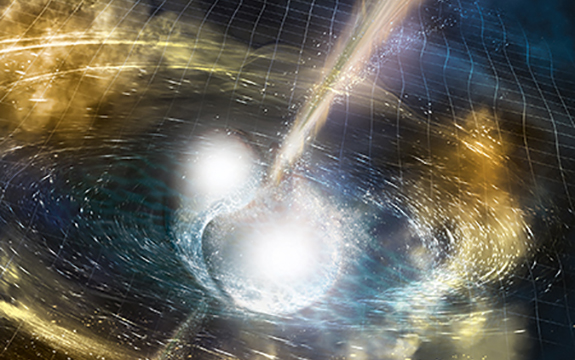Colliding stars reveal their gravitational wave secrets

In Summary
- Scientists have detected gravitational waves from the death of two neutron stars
- It is the first time a cosmic event has been observed and measured in both light and in gravitational waves
- It comes less than a month after the Nobel Prize for Physics was awarded for the discovery of gravitational waves
This event lifted the blindfolds and, wow, what an amazing show.”
Australian scientists have announced an “unparalleled” astrophysical discovery revealing that they have detected gravitational waves from the death spiral of two neutron stars.
Less than a month after three US professors were awarded the Nobel Prize in Physics for the 2015 discovery of gravitational waves, a team of Australian astrophysicists, including Swinburne researchers, have announced a new international discovery.
It is the first time a cosmic event has been observed and measured in both light and gravitational waves.
Swinburne hosts the $31.3 million Australian Research Council’s Centre of Excellence for Gravitational Wave Discovery (OzGrav) which was established last year to capitalise on the original discovery of gravitational waves.
Swinburne’s Professor Matthew Bailes, Director of OzGrav, says the new discovery has enabled scientists to pinpoint the origin of gravitational waves and to actually see “the colossal event” that accompanied the gravitational waves.
“This was the first time that any cosmic event was observed through both the light it emitted and the gravitational ripples it caused in the fabric of space and time,” Professor Bailes says.
“The subsequent avalanche of science was virtually unparalleled in modern astrophysics.”
OzGrav is a collaboration between six universities in Australia – Swinburne University of Technology, Australian National University, the University of Western Australia, Monash University, the University of Melbourne, and the University of Adelaide.
Blinkers off
Swinburne’s Associate Professor, Jeffrey Cooke, a Chief Investigator with OzGrav, says the event will go down in history as the dawn of a new era of gravitational wave multi-messenger astronomy.
“Before this event, it was like we were sitting in an IMAX theatre with blindfolds on,” he says.
“The gravitational wave detectors let us “hear” the movies of black hole collisions but we couldn’t see anything.
“This event lifted the blindfolds and, wow, what an amazing show.”
OzGrav Chief Investigator, Professor Ju Li from the University of Western Australia says: “It is extraordinary that with one faint sound, the faintest sound ever detected, we have created one giant leap in our understanding of the universe.”
Gravitational waves were first predicted by Albert Einstein about 100 years ago in his Theory of General Relativity. Einstein’s theory described how gravity warps and distorts space-time.
His mathematics showed that massive accelerating objects - such as neutron stars or black holes – that orbit each other distort both space and time and emit a type of radiation known as gravitational waves.
The resultant gravitational waves are ripples in space and time.
Einstein did not believe gravitational waves would ever be detected.
In September 2015, the California-based observatory specifically established to search for gravitational waves first sensed gravitational waves. The observatory is called aLIGO, short for the Advanced Laser Interferometer Gravitational-Wave Observatory.
Shortly after being switched on in 2015, aLIGO sensed distortions in space-time. These distortions were caused by passing gravitational waves that were generated by colliding black holes around 1.3 billion years ago.
Professors Rainer Weiss, Barry C Barish and Kip S Thorne were awarded the 2017 Nobel Prize for Physics for the discovery.
This latest event has enabled researchers to further measure gravitational waves but also see from where they originated.
Acknowledgements
LIGO is funded by the NSF, and operated by Caltech and MIT, which conceived of LIGO and led the Initial and Advanced LIGO projects. Financial support for the Advanced LIGO project was led by the NSF with Germany (Max Planck Society), the U.K. (Science and Technology Facilities Council) and Australia (Australian Research Council) making significant commitments and contributions to the project. More than 1,200 scientists and some 100 institutions from around the world participate in the effort through the LIGO Scientific Collaboration, which includes the GEO Collaboration and the Australian collaboration OzGrav. Additional partners are listed at http://ligo.org/partners.php. The Virgo collaboration consists of more than 280 physicists and engineers belonging to 20 different European research groups: six from Centre National de la Recherche Scientifique (CNRS) in France; eight from the Istituto Nazionale di Fisica Nucleare (INFN) in Italy; two in the Netherlands with Nikhef; the MTA Wigner RCP in Hungary; the POLGRAW group in Poland; Spain with the University of Valencia; and the European Gravitational Observatory, EGO, the laboratory hosting the Virgo detector near Pisa in Italy, funded by CNRS, INFN, and Nikhef.
The ARC Centre of Excellence for Gravitational Wave Discovery (OzGrav) is funded by the Australian Government through the Australian Research Council Centres of Excellence funding scheme. OzGrav is a partnership between Swinburne University of Technology (host of OzGrav headquarters), the Australian National University, Monash University, University of Adelaide, University of Melbourne, and University of Western Australia, along with other collaborating organisations in Australia and overseas.

